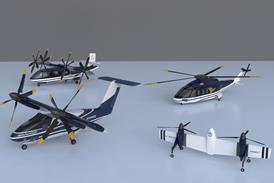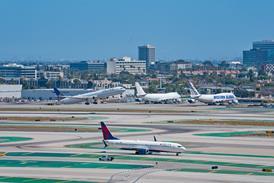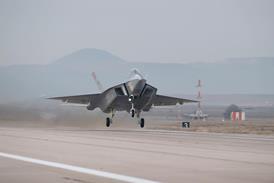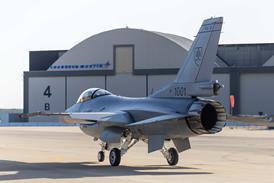The 'hushkit war' between Europe and the USA is no nearer compromise
Ramon Lopez/WASHINGTON DC
The worldwide aviation community is gearing up for the next offensive in the aero-engine "hushkit war" which has raged publicly between Europe and the USA for the past few years.
The war of words will enter the next phase in January, when the International Civil Aviation Organisation's (ICAO) Committee on Aviation Environmental Protection (CAEP) recommends a new aircraft global noise standard to the ICAO Council for adoption by the ICAO Assembly in September.
About the same time, the ICAO Council is to act on the US Government complaint against the European Commission (EC) over phasing out hushkitted aircraft. Both matters could therefore be argued before the international body at the same time and, despite efforts to keep the issues apart, it is conceivable that they will become intertwined. The forthcoming Chapter 4 noise rules perhaps will offer a compromise to the US complaint. At stake are the European Union (EU) nations' voting privileges within ICAO.
"As we enter the 21st century, noise is, and will likely remain, the number one environmental issue facing aviation and affecting continued growth and improvement of our international aviation system," says Louise Maillett, the US Federal Aviation Administration deputy assistant administrator for policy, planning and international aviation.
"We see growing political pressure internationally for tougher environmental standards. We believe that if the international community does not act in a responsible way now and demonstrate a commitment to continued progress in reducing noise, there will be increased pressure to act at the local, national and regional levels to reduce noise without regard for the impact on the aviation industry," the FAA official warns.
On 4 May, the EU's Regulation 925/1999, aimed at reducing aircraft noise at European airports took effect. This barred EU nations from adding aircraft that have been muffled via hushkitting to their registers. This "non-addition" rule is aimed at limiting European operations by many otherwise noisy aircraft that have been hushkitted and "re-certificated" to the ICAO Chapter 3 standard, escaping its ban on all Chapter 2 aircraft, which will apply from1 April 2002.
The non-addition rule is supplemented by the move to bar all "third-country" (ie non-EU) hushkitted aircraft from operating into the 15-nation union from 1 April 2002, unless they have a history of doing so, defined as having operated into the EU after 1 April 1995. Together, they effectively freeze roughly at current levels the number of hushkitted aircraft able to serve EU airports, barring the 2,000 or so Chapter 2 aircraft already hushkitted or available for hushkitting, which would, in theory, be able to fly into Europe after being made Chapter 3-compliant.
Brussels insists that it is motivated purely by environmental concerns, but the USA regards the EU's strategy as protectionist. The USA is home to both a large hushkit manufacturing industry and to airlines which operate many Chapter 2 aircraft - Boeing 727s, 737-200s and McDonnell Douglas DC-9s - that are hushkitted, or candidates for noise muffling. There are about 1,100 of these "marginally compliant" ageing civil transports which continue in service in the USA.
Protectionist strategy
US industry, claiming that $2 billion in business is at stake, pressured its government into contesting the EC rule on 14 March under Article 84 of the Chicago Convention. An EC effort failed to have the US complaint rejected, setting up a showdown before the ICAO Council in the May timeframe. If ICAO's 33-member governing body fails to resolve the matter, the complaint would be presented to the 185-member ICAO Assembly next September.
The EU contends that Annex 16 Chapter 3 of the Chicago Convention - ICAO's founding document - was never meant to include re-certificated aircraft, defined as "civil subsonic jet aircraft initially certificated to Chapter 2 or equivalent standards, or originally not noise certificated, which has been modified to meet Chapter 3 standards, either directly through technical measures or indirectly through operating restrictions." The USA's stance is that compliance with the regulation should be open to all subsonic aircraft, including derivatives.
Moves for compromise seem non-existent. The silence, as they say, is deafening. With US aerospace industry support, the USA presses on with its Article 84 complaint at ICAO, which sets and administers international certification standards for aircraft.
European transport commissioner Loyola de Palacio says the complaint "severely complicates efforts within ICAO to develop a new more stringent Chapter 4 noise standard." The new rule must "take advantage of existing and more environmentally friendly technology available, while striking a balance with the economic interests of the concerned aircraft industry". She adds: "Even though the handling of this case is just beginning, I believe that it would be appreciated if all parties tried to resume the dialogue. The noise issue concerns all citizens and deserves special attention in defining a new international standard."
Meanwhile, a move to develop a Chapter 4 noise stringency standard has advanced. The US position is that any standard must be environmentally beneficial, technically feasible and economically reasonable. Furthermore, the US backs a single global noise standard that "contains appropriate economic protections for the existing Stage 3 fleet".
The CAEP steering group has narrowed to eight the list of scenarios for cumulative 8dB, 11dB and 14dB reductions below the Chapter 3 limits. Proponents of the 8dB option include the aircraft manufacturers. Operators would keep marginally compliant Stage 3 aircraft in service to the end of their useful life. Detractors say this option is too lenient to appease affected home-owners. Backers of the 14dB option assert that the higher standard would encourage manufacturers to develop innovative technologies to address noise pollution, but critics see such a standard as too ambitious to be practical.
Should the ICAO Assembly adopt the CAEP recommendation, the Chapter 4 standard will apply to all ICAO member nations. ICAO must then decide whether to mandate a phase-out of Stage 3 aircraft, the most controversial aspect of the Chapter 4 process.
The question is whether any single option is acceptable to all nations. Advocates of phasing out marginally compliant Stage 3 aircraft claim that eliminating a small part of fleets can eliminate most aircraft noise. The US position is that normal aircraft retirement and other factors make forced retirement of Stage 3 aircraft unwarranted. US industry officials see noise management solutions, such as land use planning and zoning, and noise mitigation and sound attenuation as the key: "We need a unified, international approach that relies upon all of these techniques for real solutions - not political expediency," says the US Air Transport Association.
Phasing out
On the other hand, the Airports Council International-North America believes marginally compliant Stage 3 aircraft should be phased out in five years, with quieter aircraft within 10dB of the Stage 3 standard given additional life: "We would even be willing to entertain the suggestion that aircraft more than 10dB quieter than the Stage 3 standard may not need to be phased out at all," says ACI-NA's David Plavin.
The Coalition for a Global Standard on Aviation Noise was created to foster a new Chapter 4 noise standard without regard to the Article 84 matter. But former Virginia governor Gerald Baliles, who chairs the group, says: "The infamous hushkit dispute can be a footnote in history, or it can be a template for future international aviation relations. It all depends on whether we use this opportunity to settle the issues. The ICAO process represents our best chance to do this and I believe that the chance must be seized."
Maillett says that, given strong public pressure to act on environmental issues, "there is a strong temptation for governments to look for quick fixes outside of the international process. These unilateral actions open the door for balkanisation of international civil aviation standards and regulations, and could destroy the very stability that has allowed the industry to thrive, while reducing aircraft noise. The CAEP process affords us an opportunity to avoid that unfortunate outcome."
Source: Flight International























